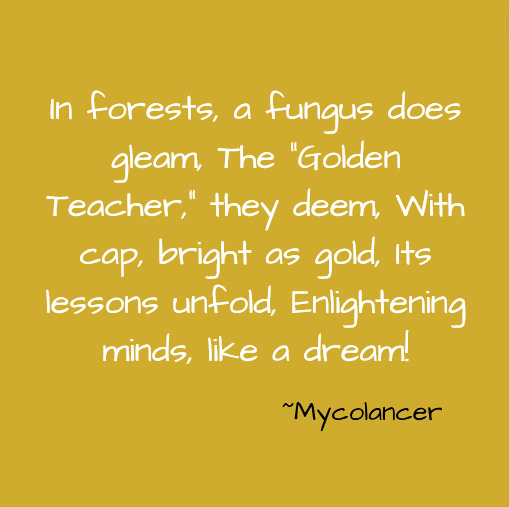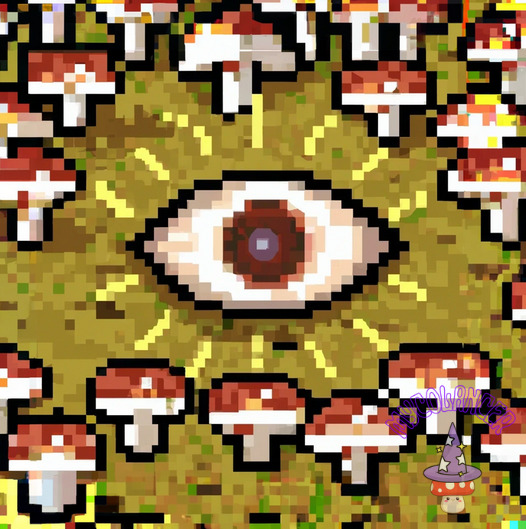#Mycolancer's Meetings
Text
youtube
Our 2/26 AMA meeting is now on Youtube! I answer several questions, including ones about psilocybin mushrooms and sex! Give it a listen, and please reblog to others can find it!
Mush love,
Mycolancer
#AMA#Ask Me Anything#Mycolancer#Mycolancer's Meetings#psilocybin#psychonauts#wellness#harm reduction#mushrooms#magic mushrooms#harm reduction education#mushroom#drug chemistry#youtube video#Youtube
0 notes
Text
A brief history of the ancient use of Golden Teacher by Mycolancer

The "Golden Teacher" is a colloquial term often used to refer to a specific strain of psychedelic mushrooms, scientifically known as psilocybe cubensis. These mushrooms have been used for centuries in various cultural and spiritual contexts. When discussing the pre-colonial history of the use of Golden Teacher mushrooms, it's essential to remember that specific strain names like "Golden Teacher" are relatively recent and are more commonly associated with modern cultivation. However, the broader history of p. cubensis and its traditional use can be traced back in different parts of the world.
Indigenous Use in Mesoamerica:
p. cubensis mushrooms, including the potential ancestors of the "Golden Teacher" strain, have been used by indigenous peoples in Mesoamerica for thousands of years. The Aztecs, in particular, used them in religious and shamanic rituals. The Aztec name for these mushrooms was "teonanácatl," which means "flesh of the gods." The use of these mushrooms was closely tied to their spiritual and cultural practices.
Pre-Colonial Shamanic Practices:
Indigenous shamans and healers in regions such as present-day Mexico and Guatemala would ingest p. cubensis mushrooms to induce altered states of consciousness. They believed these altered states allowed them to communicate with the spirit world, receive divine guidance, and heal the sick, among other reasons.
Cultural Significance:
The use of these mushrooms was deeply ingrained in the cultural and spiritual heritage of various indigenous groups, and it was considered a sacred and profound practice. The experiences induced by p. cubensis were seen as a way to gain insight, resolve conflicts, and connect with the natural world. This is not meant to be a complete list of all uses and intentions within these many cultures.
European Contact and Suppression:
When European colonizers arrived in the Americas, they often suppressed indigenous cultural practices, including the use of p. cubensis. Many native rituals involving these mushrooms were deemed heretical by the Catholic Church, leading to their suppression and persecution.
Modern Rediscovery:
The use of Psilocybe cubensis mushrooms was largely forgotten during the colonial period and subsequent centuries. It was only in the mid-20th century, with the work of scholars like R. Gordon Wasson, that these mushrooms and their cultural significance began to be rediscovered by the Western world. Wasson's experiences with Psilocybe mushrooms in Mexico contributed to a renewed interest in psychedelic substances.
The specific strain known as "Golden Teacher" is a more recent development, primarily within the context of modern cultivation and recreational use. It is important to understand that the contemporary naming and identification of strains like "Golden Teacher" stem from efforts to distinguish between different varieties of Psilocybe cubensis based on their growth characteristics, appearance, and potency. The use of these strains, while still tied to psychedelic experiences, differs significantly from the traditional indigenous practices of Mesoamerica and should be approached with caution and respect for the cultural and historical context in which they were used.
This article is not meant to be an extensive source of information. We will get into deeper understanding of what is known about indigenous use of psilocybin containing mushrooms in future articles. You can join our Discord Server to join in on meetings every month to participate in discussion and shared learning. To join contact Mycolancer on Telegram, same username.
#indigenous#indigenous culture#indigenous history#indigenous people#Psilocybe Cubensis#P. cubensis#Magic Mushrooms#Spiritual Ritual#shamanism#shamanic#psilocybin#psychonauts#mycolancer#harm reduction#mushrooms#harm reduction education#Mushroom Poem#poetry#poems on tumblr#history lessons#historic#psychonaut life
1 note
·
View note
Text
Unveiling the Magic of Psilocybin: Nature's Trippy Molecule by Mycolancer

In addition to writing, I make, art, too!
Psilocybin, the primary psychoactive compound found in psychedelic mushrooms, has fascinated scientists, researchers, and enthusiasts for its role in altering perception, cognition, and consciousness. While Psilocybin takes the center stage, there's a lot more to the magic mushroom experience than meets the eye. In this blog post, we'll delve into the chemical structure of Psilocybin, explore other active compounds in these mushrooms, and consider why consuming the whole mushroom might be a better option than using synthetic Psilocybin.
Psilocybin's Chemical Structure
Psilocybin, also known as 4-phosphoryloxy-N,N-dimethyltryptamine, is a naturally occurring hallucinogen. Its molecular structure is comprised of a tryptamine ring, a phosphorous molecule, and two methyl groups. When ingested, Psilocybin is metabolized in the body into Psilocin, which is responsible for the mind-altering effects.
The Team of Active Compounds
Psilocybin mushrooms are like a treasure trove of compounds that work together to create a unique psychedelic experience. Besides Psilocybin, they contain other active compounds, most notably Psilocin, baeocystin, and norbaeocystin. These compounds are chemically similar to Psilocybin and share similar psychoactive properties.
Psilocin, in particular, is a close relative of Psilocybin and is responsible for many of the effects experienced during a magic mushroom trip. It interacts with serotonin receptors in the brain, which is thought to be the key to the profound shifts in perception, mood, and consciousness.
Baeocystin and norbaeocystin are less studied but are believed to contribute to the overall psychedelic experience. While their exact roles are not well-documented, it's clear that they play a part in shaping the unique character of the magic mushroom journey.

Why Whole Mushroom Consumption is Preferred
There's a growing interest in isolating Psilocybin from mushrooms and using it synthetically, mainly for standardized dosing and medical applications. However, many enthusiasts argue that consuming the whole mushroom offers a more holistic and natural experience for several reasons.
The Entourage Effect: Magic mushrooms contain a blend of active compounds that work together synergistically. This "entourage effect" may offer a more balanced and nuanced experience compared to isolated Psilocybin.
Safety: In their natural form, Psilocybin mushrooms have been used for centuries in traditional shamanic rituals with relatively few reports of adverse effects when used responsibly. Synthetic Psilocybin may not carry the same historical safety record.
Mystical and Therapeutic Benefits: Many users believe that the unique blend of compounds in magic mushrooms contributes to the profound, therapeutic, and mystical experiences associated with them. The synergy between these compounds is thought to enhance the overall therapeutic potential.
In conclusion, Psilocybin is a fascinating molecule, and the magic mushroom experience is more than just this single compound. The team of active compounds in these mushrooms works together to create a unique and profound journey. While synthetic Psilocybin has its advantages, the holistic nature of whole mushroom consumption cannot be understated, offering a rich and multidimensional experience that continues to intrigue and inspire. Always remember that the use of psychedelic substances should be approached with respect, caution, and responsibility.
#pharmacology#drug chemistry#harm reduction#mushrooms#wellness#Psilocybin#Psilocin#Mushrooms#Pschedelics#Harm Reduction Education#Mycolancer#Original Post#Original Content#Trippy Art#Digital Psychedelic Art#Mandala#Abstract Trippy Art#Psychonauts#Psychonaut Life#Microdosing#Microdose#Shrooms#Fungi#Psilocybe Cubensis
0 notes